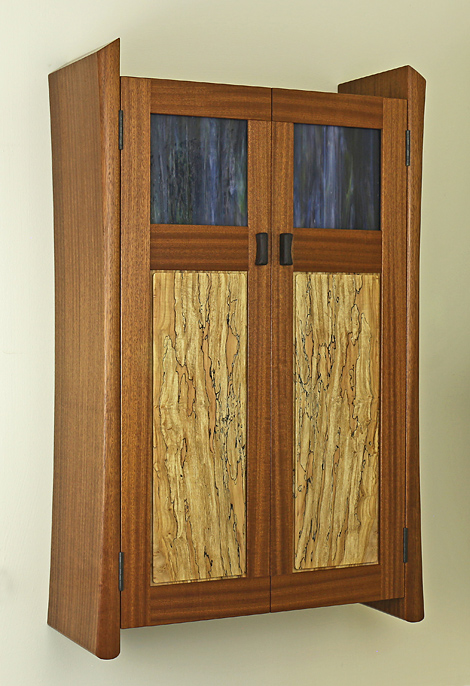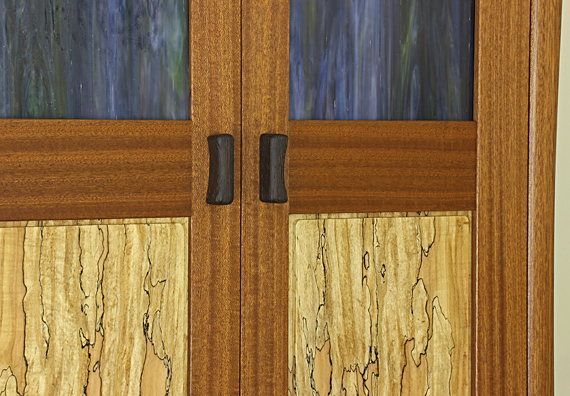
[32″h x 20″w x 8″d] The curved sides of this cabinet started on the bandsaw, of course, but then I used the #20 compass plane, the RP rasp, and scrapers. The best tool for final truing of the curves was a simple purpose-built sanding shave. This is just a 14″-long stick, about 1″ x 2″, with the working wide face planed a bit convex, to which is attached PSA sandpaper.
With all the tools on which we spend a small fortune, almost every project necessitates a shop-made tool to save the day.
The dowel joinery went well. I have plenty of experience with it. Well, except for one section where I used too much glue and paid the price correcting a squeeze-out mess. Think! It is so much easier to avoid than to correct mistakes.
Just clamp the carcase together, right? No. The curved sides required specially shaped clamp blocks. It was so easy to draw that nice curve on paper . . .
For the door frame joints, I choose regular mortise-and-tenons rather than slip joints, which look cool but are a major pain to clamp. I routed the mortises and then carefully set up the bandsaw to make the tenons within a shaving or two (or none) with the rabbet block plane. It’s all about making a precise kerf-width-thick gauge.

There’s a limit to masochism, or maybe not. The unconventional arrangement of the door frame rails and stiles made the final fitting of the doors more difficult. This was, however, a key design element of the piece so it was worth the trouble. The step at the junctions of the inner rail and stile on each door was another pain. A bigger pain would have been to try to assemble the door pieces in the wrong (impossible) order.
After a lot of mulling over, I decided to use magnetic catches. I should have embedded the fixed magnets in the fixed shelf but I made a separate little block for them, which could be removed and replaced if everything did not work out. The catches work nicely but I should not have chickened out on the design.
See the convex front edge of the sides? That feature made everything more difficult, especially the final fit of the doors. Does it matter? Yea, I think so; I like the look. It’s just a matter of deciding if it is worth it.
The problem with one-of-a-kind work is that you never experience all the issues and see the end point until you’re done. Yes, I would have done some things differently if I were to make this again. But I’m not going to.
The top panels are opalescent art glass. I learned a lot about art glass and glass cutting tools and techniques for this project. I installed the glass with strips that are screwed in place, not nailed as Krenov did.
From the start, I planned to use Z-clips to hang the cabinet. These are essentially metal French cleat hangers but take up only 1/4″ of depth in the back of the cabinet. They must be accounted for when forming the rabbet for the back panel, including some consideration for walls not being perfectly flat.
Virtually every project requires learning about a new material, technique, finish, or design element. I enjoy that.
The spalted big-leaf maple panels were a nice find, and they bookmatched well for spalted wood. Like most well spalted material, there were some soft areas that needed hardening. Protective Coatings PC-Petrifier works well with minimal darkening.
For the hinges, bright or even brushed brass just would not look right, and the antiquing on the hinges that I bought proved to be delicate, so I blackened them for good with a solution from Rockler.
I could go through a dozen or more other special issues with this piece but you get the idea. The truth is that there is a lot of thought, time, trouble, and – is suffering too strong a word? – in making these things.
Are these details worth it? How about the specialized tools, finding the right wood, correcting mistakes, refining the design (over and over), finding the way out of construction problems, and on and on?
Only the maker can answer these questions. That’s the privilege – and the joy – that comes with making things. Best wishes for you and your projects.


It will be what is rarely written – a real accounting of a maker’s thoughts from the first idea for a piece through its completion. I will relate my ambitions, joys, frustrations, doubts, successes, failures, and more – all unvarnished and “from the shavings and sawdust of my shop” – in building the piece that started with the sketch above.
I could go through a dozen or more other special issues with this piece but you get the idea. The truth is that there is a lot of thought, time, trouble, and – is suffering too strong a word? – in making these things.
You chickened out, I really did want your “unvarnished thoughts”. Beautiful piece.
Thank you for sharing. To answer your main question, yes it is worth it. Decades from now, you will still smile fondly at this piece knowing what you did to make it happen and for all these details. Most folks will just see a nice piece for furniture, you will get to relive the thrill of making it come together.
Lovely cabinet, and thanks to James Krenov for the spirit and inspiration to take on the challenge.
Of course it’s worth it. Isn’t that why we spend so many hour in the shop? Even after forty years in the shop I make it a point to add challenges in order to learn a new skill or technique. My most recent project, a three cabinet media credenza 10 1/2 feet long is presenting me with the most basic challenge. The top is to be made from three pieces of 2 1/4 walnut 8” to 9” wide. I have access to a 12” Grizzly joiner, but these bards are too heavy to muscle through on edge (too much weighed extending beyond the table. My Inca 510 isn’t even close to being of use. They are flat and free of bow and twist. I hand planed one surface and power planed the other parallel. It seems that my only option is hand joining them. I have a 6’ straight edge and am thinking of making one 10’ long out of 3/4 stock as this will be infinitely easier to handle as I work an edge. I would appreciate any tips, comments, or advice on this process. By the way I plan to glue them up and finish them in the room of install.
Joe,
Thank you. Krenov expressed a similar sentiment somewhere in one of his books.
Dan,
Thank you. Yes, it is worth it. I left the question unanswered in the post because it is one that each crafter must ask for himself.
That’s a tough glue up! How ever you decide to work the joint faces, the goal is to have no hump either along or across them. A trace, just a trace, of valley should be OK, but just as a one-sided tolerance because those beefy boards will have almost no flex.
I’d also make sure the mating edges are alike in grain orientation. For example, meet 45° rift to 45° rift, or quartered to quartered, etc. because you don’t want wood movement fighting the glue line later on.
I suggest do not bother with a giant straight edge. The best pre-test of this joint, like any edge-to-edge joint, is to stand one board on its side (best in the bench front vise) and place the other on top with the joint faces together. Then, try gently rotating and rocking the top board. If the top board pivots somewhere in the middle or subtly rocks (because the faces are in wind to each other), then the joint may gap later. The top board should just barely grip the bottom board at the ends of the joint and across its width. Also, hold a straightedge across the width of the joint to see if the joint is destined to produce a board flat across its width. These tests are more sensitive than a straightedge assessment directly on the joint faces, and it is a more direct test.
You can use the big straightedge that you have to check you planing as you work but the best final test, in my opinion, is what I described above.
(By the way, there’s lots of info in the edge joint series on this site and in my three articles in Furniture and Cabinetmaking magazine July, August, and October 2017.)
For alignment, I like to use biscuits for edge-to-edge joints thicker than about 5/8″. They also can help prevent “that first letting go” (Krenov’s words), even though in theory they are not necessary for this. In any case, they decrease stress at glue up time, I find.
Bob,
I appreciate your interest. Even if you are disappointed in what I wrote or didn’t write, there certainly is no way you can know if any lack of content was because “I chickened out.” In fact, I wrote what I wanted to. If there is something else you would like me to add, why not just ask? I’m happy to answer if you leave out the presumptive tack.
Rob
Thanks for your answer. Per your prompt I re-read your series on edge gluing. I began working these boards. Joint #1 is very close to being done I have about 0.055” of spring in the center along the length. Amazingly one lightweight clamp can pull this out with very little effort. I plan to reduce the gap to 0.020 or less. Joint #2 needs a little more work as it has a small hump at center along the length. The third board also contains a bit of wind. As I have more width than needed I’ll rip this third board before addressing the winding. I didn’t mention this is walnut I have air dried for several years. Just prior to planing it was in my attached garage and a few days ago I moved it into the shop and I am letting it acclimate to these conditions and therefore not rushing the edge gluing process.
Thanks again. Your most recent post about PVA glue is quite timely. I’m trying to decide between Old Brown Glue and Titebond III. I suspect the flexibility of TB III could be an advantage in these long joints, however I like the open time of OBG.
Sounds like you’ve got it covered, Dan. The biggest potential stress on those joints, by far, is from hygroscopic wood movement. I assume those thick boards are flatsawn and so there is necessarily some movement conflict at the glue line.
Wood has some elasticity too, so you’re probably fine with any glue with a well made joint. Personally, I’d lean toward the TBIII if you can work fast.
Rob